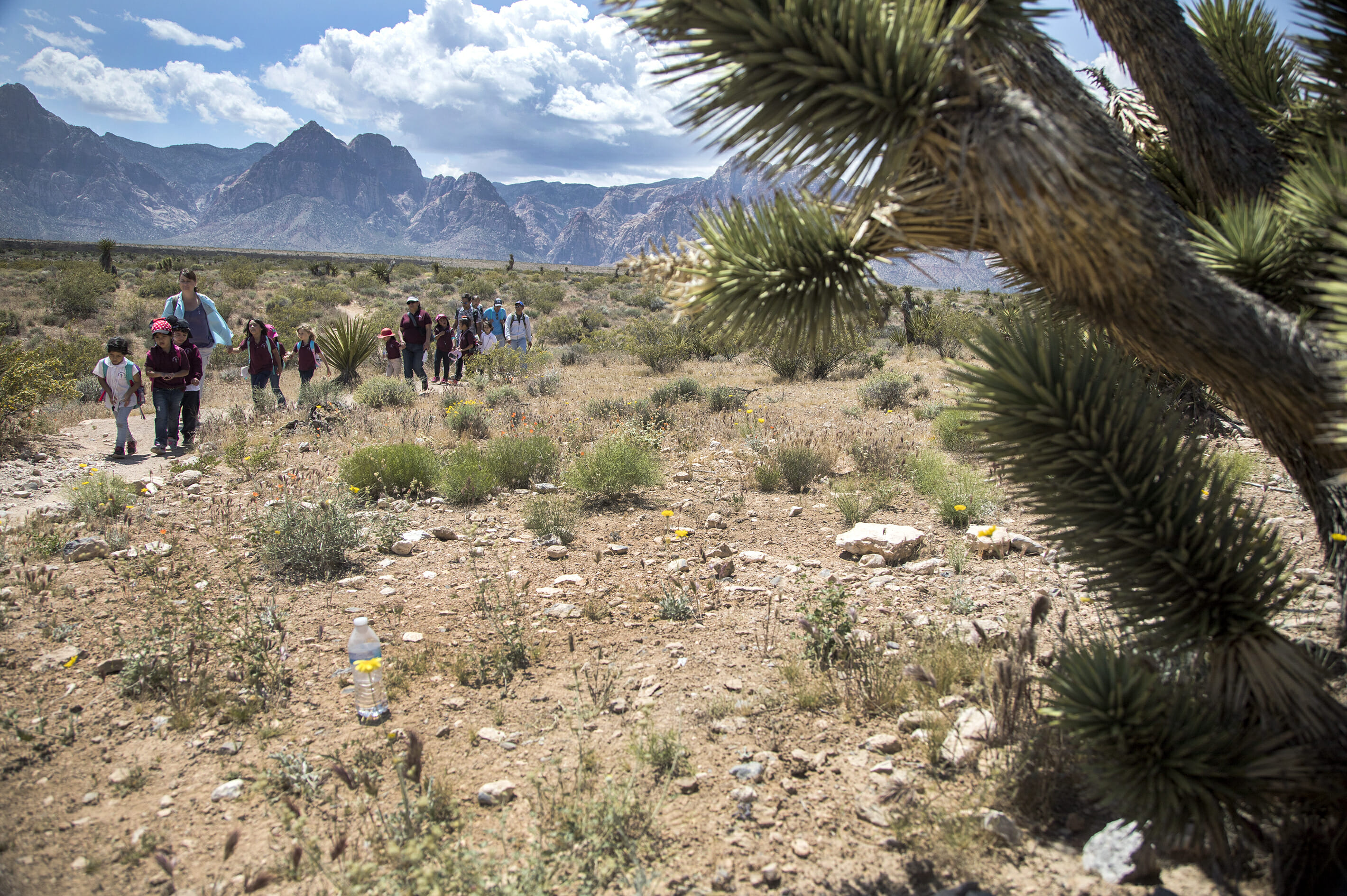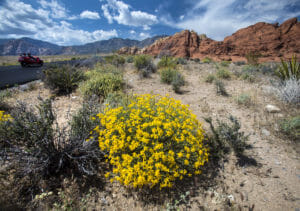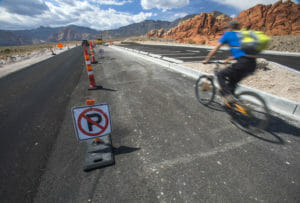A new playground: Adventure seekers fuel booming outdoor recreation business in Nevada

Mountain biking in Caliente. Heli-skiing near Elko. Rock climbing in Las Vegas. Stargazing in central Nevada. Off-roading near Fallon. And snowboarding at Lake Tahoe.
These are just some of the activities luring people to the Silver State that don’t involve slot machines, poker chips and playing cards. Outdoor recreation represents a growing segment of Nevada’s economic landscape, state officials say, propelled by people’s heightened interest in nature and out-of-the-way adventures.
Last year, a record number of people — more than 9.1 million — visited state or national parks in Southern Nevada, according to the Las Vegas Convention and Visitors Authority. That figure doesn’t include tourists who used Las Vegas as their gateway to neighboring western attractions, including Zion National Park in Utah and Grand Canyon National Park in Arizona.
“It’s more and more crowded all the time,” said Michael Goldsmith, the LVCVA’s vice president of international marketing.
Drive to Red Rock National Conservation Area any weekday and there’s a steady stream of vehicles pouring into the 13-mile scenic loop. On a recent Tuesday, the guestbook contained messages from visitors representing nearly all corners of the country: Hernando Beach, Fla.; Springfield, Ohio; Buffalo, N.Y.; Fayetteville, Texas; and Los Gatos, Calif. to name a few.

Among the visitors was Bob Walker, a Los Angeles resident who’s a doctoral student at UNLV. He visits Las Vegas once a month and often makes a Red Rock stop along the way. This time he brought his wife, who had never been to the conservation area.
“Las Vegas is more than gambling,” Walker said. “It really is.”
THE MONEY FACTOR
The increasing popularity of Nevada’s outdoor treasures — and the recreation opportunities that exist within — comes amid greater scrutiny of two more recent additions to its portfolio. Earlier this month, President Donald Trump issued an executive order that’s triggering a review of national monument designations, including Gold Butte and Basin and Range, which former President Barack Obama created during his administration.
The review puts the national monuments at risk of being rescinded, resized or modified. Possible changes will be based on recommendations made by the Department of Interior, whose secretary, Ryan Zinke, called the review “long overdue” and said the federal government has received complaints that some monument designations led to job loss, reduced wages and restricted public access to the land.
A report recently released by the Outdoor Industry Association, however, paints a much rosier portrait of federal lands’ effect on the economy. The association estimates that national parks, wildlife refuges, monuments and other public lands and waters generate $45 billion in economic output and account for roughly 396,000 jobs nationwide each year.
Furthermore, outdoor recreation as a whole creates $887 billion in consumer spending annually, 7.6 million jobs, $65.3 billion in federal tax revenue and $59.2 billion state and local tax revenue, according to the Outdoor Industry Association. The report — the third of its kind by the Boulder, Colorado-based organization — essentially makes the case for why preserving land and water assets makes sense from a dollar perspective.
“Public lands and waters are the outdoor industry’s basic infrastructure, and without them the industry cannot survive,” the report states. “Preserving access is imperative to enhancing the industry’s economic and social impact. Access ensures every American’s ability to get outside where jobs, health and communities grow.”
As the industry gains more steam, the federal government is taking note. Late last year, Congress passed the Outdoor Recreation Jobs and Economic Impact Act, which directs federal agencies to measure outdoor recreation’s yearly contribution to the nation’s gross domestic product.
Here’s what Nevada tourism officials already know: Outdoor recreation is big business in this large state that boasts vast open spaces and diverse landscape features.

Direct spending on outdoor recreation — for instance, park and activity fees or equipment costs — pumped roughly $400 million into the state’s economy in 2015, said Claudia Vecchio, director of the Nevada Department of Tourism and Cultural Affairs. That figure is up from previous economic impact studies, which pegged it at somewhere in the $300-million range.
Direct spending does not include indirect expenses such as food or lodging, meaning outdoor recreation’s effect on the state economy is likely far greater given the trickle-down effect: People may buy gas on their way out to a hiking destination and then grab food or drinks afterward. Or if they’re tourists, they may be staying in hotels, gambling and seeing shows in addition to their outdoor pursuits.
“I think people are realizing that just sitting at home watching TV and playing video games isn’t all it’s cracked up to be,” said Barb Keleher, the Bureau of Land Management’s recreation program lead in Nevada.
LAND OF OPPORTUNITIES
The BLM manages 48 million acres of public land in Nevada, much of which lends itself to recreation activities. About 8 million people visited BLM land in Nevada last year.
As visitation increases, the land management agency has been busy outfitting areas with necessary upgrades, including more parking at Red Rock and Sloan Canyon National Conservation Area, Keleher said. A small visitor center for Sloan Canyon is in the planning stages.
Farther north, the BLM is working with partners to open a 40-mile mountain-bike trail in Caliente, a small town in Lincoln County. A similar bike trail is planned for Beatty as well.
Vecchio said the state’s rural residents largely are welcoming the infrastructure upgrades because it’s an economic-development opportunity that might not otherwise exist. Plus, she said outdoor recreation tends to attract a desired type of tourist — someone who cares about nature and wants to preserve it.
“It’s a good traveler to go after and build the kind of infrastructure they need,” she said.

But it’s not just government agencies ramping up recreational offerings. Businesses hoping to capitalize on people’s thirst for outdoor adventures have popped up across the state, offering experiences such as guided hikes, kayaking tours and even yoga atop rock formations at Valley of Fire State Park via helicopter delivery, Goldsmith said.
“That’s just a perfect example of taking advantage of the natural beauty and mixing so many things with it,” he said. “That’s a revenue generator.”
State tourism officials believe Nevada is ripe with more untapped recreation opportunities, especially in the recently designated monument areas, both of which are within striking distance of Las Vegas. Basin and Range National Monument occupies more than 700,000 acres of wilderness in Nye and Lincoln counties — about a two-hour drive from Las Vegas. Gold Butte National Monument, which covers nearly 300,000 acres, lies about an hour and a half northeast of the state’s main population center.
Goldsmith said the LVCVA has received inquiries about those areas since their designation. While the tourism agency hasn’t taken an official stance on Trump’s executive order, Goldsmith said he would be “reluctant” to see any reductions in land protections occur.
“We market Las Vegas as the hub to the southwest,” he said. “We support continuing to protect natural land such as Gold Butte.”
But Vecchio said the state tourism office isn’t overly concerned about the review of national monuments. Even if the label goes, the land stays.
“What they do with the national monument status is kind of out of our hands,” she said. “People will come to these areas and do their outdoor activities in the areas regardless.”
A bigger barrier to outdoor recreation, she said, is lack of education. While outdoor recreation has been increasing, there’s still a large chunk of state residents, particularly in urban areas, who simply don’t know what Nevada has to offer.
Vecchio said it’s the state’s responsibility to bolster awareness about those opportunities and promote more exploration by people of all ages.
“We’re more about the adventurous spirit than how old you are,” she said. “Anybody at any age can have this great thirst for adventure.”
Feature photo: People hike near the Red Rock Canyon National Conservation Area Visitor Center on Tuesday, May 9, 2017. Photo by Jeff Scheid.
